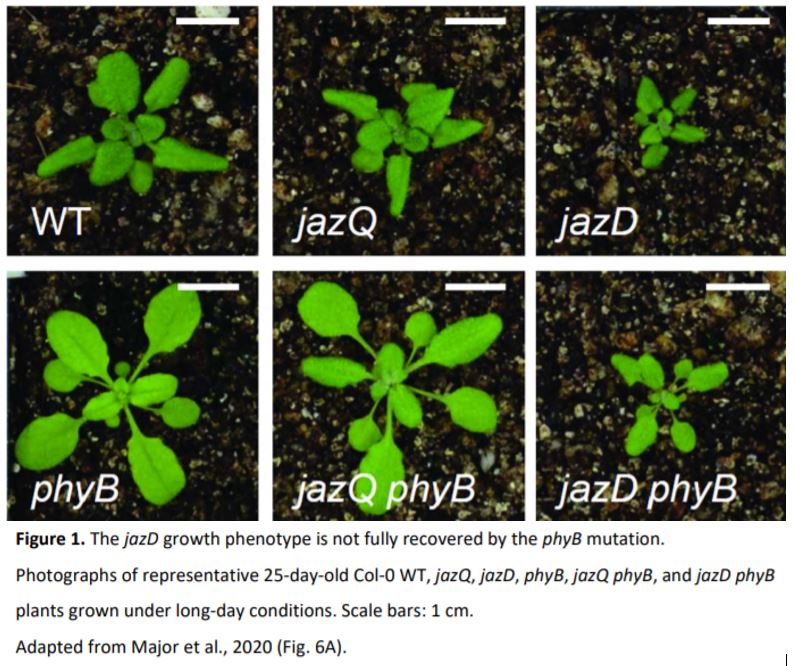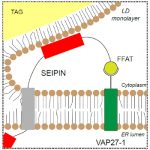To grow or defend? More on the plant cornelian dilemma
Author
Anne-Sophie Fiorucci
Affiliation
Centre for Integrative Genomics, Faculty of Biology and Medicine, Génopode Building, University of Lausanne, CH-1015 Lausanne, Switzerland.
ORCID number
0000-0002-3254-5967
Growth and defense are usually opposed as two energy-consuming aspects of what a plant needs for survival and have long been described as parts of a plant dilemma (Herms and Mattson, 1992). Indeed, when challenged by pathogens or predators, plants deploy an array of defense mechanisms that often lead to growth restriction and/or a decrease in reproductive output. By contrast, in dense environments, strong competition for light perception triggers growth in shade-avoiding species as a way to outgrow neighbors, but it also inhibits defense (Ballare, 2014; Ballare and Pierik, 2017). Because of its profound impact on plant fitness and yield, understanding the growth–defense tradeoff is of utmost importance, especially in agriculture.
Among the different hormones that control defense pathways, the lipid-derived jasmonates (JAs) are associated with responses to herbivores and necrotrophic pathogens, and with growth inhibition. In a resting state, proteins from the JAZ family (JASMONATE ZIM-DOMAIN) inhibit JA-dependent defenses by preventing the action of MYC transcription factors. Upon attack, JA levels increase and JAZ proteins are degraded, which releases the activity of MYCs and allows a massive transcriptional reprogramming (Wasternack and Song, 2017).
A classical explanation of the growth–defense tradeoff is that plants have a global pool of resources to allocate to one mechanism or the other, so the high metabolic cost of one process may indirectly impact the other. However, more and more studies challenge this resource-based model (Zust and Agrawal, 2017). For example in Arabidopsis thaliana, mutations in the gene encoding the red/far-red-sensing photoreceptor phyB fully rescue the growth defect of a quintuple jaz mutant (jazQ, Figure 1). In parallel, phyB maintains the constitutive activation of defense of the jazQ background (Campos et al., 2016). Therefore, jazQ phyB plants display the capacity to both grow and defend at the same time, which means that growth and defense are genetically uncoupled in the jazQ phyB sextuple mutant. The same observations were made using a jaz10 phyB double mutant (Cerrudo et al., 2017). Both studies thus support the idea that the growth–defense tradeoff can also be explained by tightly controlled antagonistic transcriptional networks. However, in both cases there is only a mild activation of defense because many genes of the JAZ family are still active. What happens in the case of a strong unrestrained defense activation? Is it possible to get strong defenses and robust growth?
 In this issue of Plant Physiology, Major et al. (2020) use a genetic approach to test how high levels of defense impact growth in Arabidopsis. To do so, the authors took advantage of a jaz decuple mutant (jazD) that is mutated in 10 of the 13 JAZ genes (Guo et al., 2018). jazD is highly resistant to necrotrophic pathogens and insects, and displays strongly reduced growth (Figure 1) and fertility. The jazD mutant is thus much more affected than the jazQ mutant (Figure 1) (Campos et al., 2016; Guo et al., 2018). The authors conducted a genetic suppressor screen to identify loci whose mutation would rescue jazD growth defects but not the high defense levels (Major et al., 2020). Among 13 suppressors showing a partial recovery of rosette growth, 9 also display elongated hypocotyls and petioles. All of them carry mutations in PHYB. Further genetic crosses to obtain jazD phyB mutant plants with the “classical” phyB-9 mutant allele confirmed the results of the genetic screen (Figure 1).
In this issue of Plant Physiology, Major et al. (2020) use a genetic approach to test how high levels of defense impact growth in Arabidopsis. To do so, the authors took advantage of a jaz decuple mutant (jazD) that is mutated in 10 of the 13 JAZ genes (Guo et al., 2018). jazD is highly resistant to necrotrophic pathogens and insects, and displays strongly reduced growth (Figure 1) and fertility. The jazD mutant is thus much more affected than the jazQ mutant (Figure 1) (Campos et al., 2016; Guo et al., 2018). The authors conducted a genetic suppressor screen to identify loci whose mutation would rescue jazD growth defects but not the high defense levels (Major et al., 2020). Among 13 suppressors showing a partial recovery of rosette growth, 9 also display elongated hypocotyls and petioles. All of them carry mutations in PHYB. Further genetic crosses to obtain jazD phyB mutant plants with the “classical” phyB-9 mutant allele confirmed the results of the genetic screen (Figure 1).
The authors then tested the phenotypic responses of jazD phyB. As in jazQ phyB (Campos et al., 2016), the phyB mutation does not alter the hypersensitivity to JA or the constitutive activation of JA defenses in jazD. But in contrast to the jazQ background, phyB does not fully rescue the growth phenotype of jazD (Figure 1). This observation is particularly striking in long days, whereas the rescue gets better, though not complete, under short-day conditions. Similar to jazD, jazD phyB plants produce many fewer seeds than wild-type plants. Therefore, the growth inhibition associated with a strong induction of defense in jazD cannot be fully alleviated, which means that the uncoupling of growth and defense depends on the level of defense.
The severe JAZ depletion in jazD is associated with a reallocation of metabolic resources to defense compounds and symptoms of carbon starvation (Guo et al., 2018). One interpretation is that JAZ proteins normally prevent the disastrous metabolic consequences of an uncontrolled activation of the JA defense pathway. Is the growth defect observed in jazD phyB also due to changes in central metabolism? The answer is apparently no; at least, the authors could not find any association between growth and general carbon metabolism pathways in jazD phyB. By contrast, the growth phenotypes of the different mutants (Figure 1) are consistently associated with tryptophan metabolism, in terms of gene expression, metabolite levels and sensitivity to a chemical inhibitor of tryptophan biosynthesis. Many metabolic pathways start with tryptophan, including biosynthesis of auxin or of defense compounds like indole glucosinolates. However, the link between changes in tryptophan metabolism and reduced growth in jazD and jazD phyB is not fully understood. Plants might compensate for the potential metabolic imbalance due to the redirection of primary metabolites to the increased production of chemical defenses. There could also be an alteration of auxin production.
The study by Major et al. (2020) confirms that the balance between growth and defense depends on how strongly the immune response is activated. It also validates the crucial role of phytochrome photoreceptors, especially phyB, in JA-induced growth restriction (Campos et al., 2016; Cerrudo et al., 2017; Major et al., 2020). The results from Major et al. (2020) further connect photoperception and defense pathways, adding to the recent discovery of a direct metabolic link between phyB and the reduction of JA levels under shade-avoidance conditions (Fernandez-Milmanda et al., 2020). Importantly, the fact that phyB mutation could not rescue the strong growth defect of jazD highlights the existence of a yet-unknown phyB-independent pathway that restrains growth under high levels of defense. In that case, it is possible that the growth–defense tradeoff cannot rely on transcriptional networks only but also depends on strong metabolic constraints due to the reallocation of metabolites to defense. Future studies will surely bring exciting insights into how plants regulate these two fundamental aspects of life.
References
Ballare, C.L. (2014). Light regulation of plant defense. Annu Rev Plant Biol 65, 335-363.
Ballare, C.L., and Pierik, R. (2017). The shade-avoidance syndrome: multiple signals and ecological consequences. Plant Cell Environ 40, 2530-2543.
Campos, M.L., Yoshida, Y., Major, I.T., de Oliveira Ferreira, D., Weraduwage, S.M., Froehlich, J.E., Johnson, B.F., Kramer, D.M., Jander, G., Sharkey, T.D., and Howe, G.A. (2016). Rewiring of jasmonate and phytochrome B signalling uncouples plant growth-defense tradeoffs. Nat Commun 7, 12570.
Cerrudo, I., Caliri-Ortiz, M.E., Keller, M.M., Degano, M.E., Demkura, P.V., and Ballare, C.L. (2017). Exploring growth-defence trade-offs in Arabidopsis: phytochrome B inactivation requires JAZ10 to suppress plant immunity but not to trigger shade-avoidance responses. Plant Cell Environ 40, 635-644.
Fernandez-Milmanda, G.L., Crocco, C.D., Reichelt, M., Mazza, C.A., Kollner, T.G., Zhang, T., Cargnel, M.D., Lichy, M.Z., Fiorucci, A.S., Fankhauser, C., Koo, A.J., Austin, A.T., Gershenzon, J., and Ballare, C.L. (2020). A light-dependent molecular link between competition cues and defence responses in plants. Nat Plants 6, 223-230.
Guo, Q., Yoshida, Y., Major, I.T., Wang, K., Sugimoto, K., Kapali, G., Havko, N.E., Benning, C., and Howe, G.A. (2018). JAZ repressors of metabolic defense promote growth and reproductive fitness in Arabidopsis. Proc Natl Acad Sci U S A 115, E10768-E10777.
Herms, D.A., and Mattson, W.J. (1992). The Dilemma of Plants – to Grow or Defend. Q Rev Biol 67, 283-335.
Major, I.T., Guo, Q., Zhai, J., Kapali, G., Kramer, D.M., and Howe, G.A. (2020). A Phytochrome B-independent Pathway Restricts Growth at High Levels of Jasmonate Defense. Plant Physiol. https://doi.org/10.1104/pp.19.01335
Wasternack, C., and Song, S. (2017). Jasmonates: biosynthesis, metabolism, and signaling by proteins activating and repressing transcription. J Exp Bot 68, 1303-1321.
Zust, T., and Agrawal, A.A. (2017). Trade-Offs Between Plant Growth and Defense Against Insect Herbivory: An Emerging Mechanistic Synthesis. Annu Rev Plant Biol 68, 513-534.



